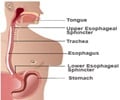About
Pediatric pyloric stenosis is narrowing of the pylorus i.e. the lower part of the stomach.

Pediatric pyloric stenosis is narrowing of the lower end of the stomach due to thickening of the muscles of the pylorus. The narrowing is up to the extent that milk and other stomach contents cannot pass into the small intestine. It is also known as ‘infantile hypertrophic pyloric stenosis’ (IHPS).
Pyloric stenosis typically affects babies 4-6 weeks after birth. The exact cause of this problem is not known.
The most common symptom of pyloric stenosis is forceful and projectile vomiting. Other symptoms include dehydration, weight loss, fewer bowel movements and mild jaundice.
Consistent history and description of the vomiting pattern and appearance, and palpation of a small lump in the mid abdomen are indicative of
Pediatric pyloric stenosis is a medical emergency and requires immediate treatment. Correction of fluid loss, electrolytes, and acid-base imbalance is the first concern; after which a surgical procedure called pyloromyotomy is performed to correct the stenosis.








